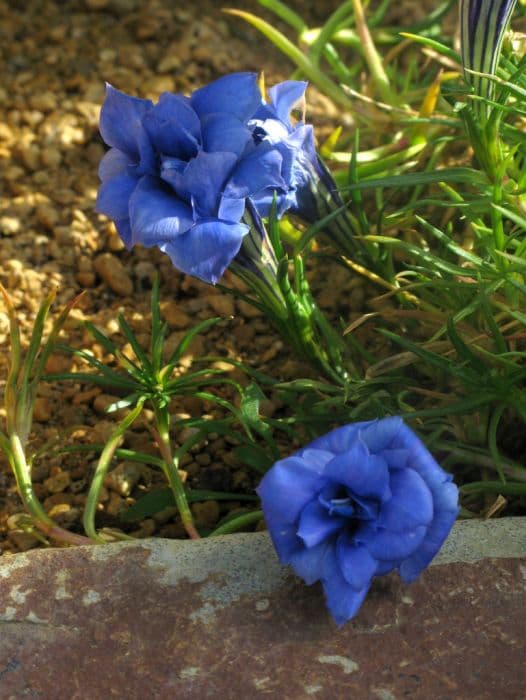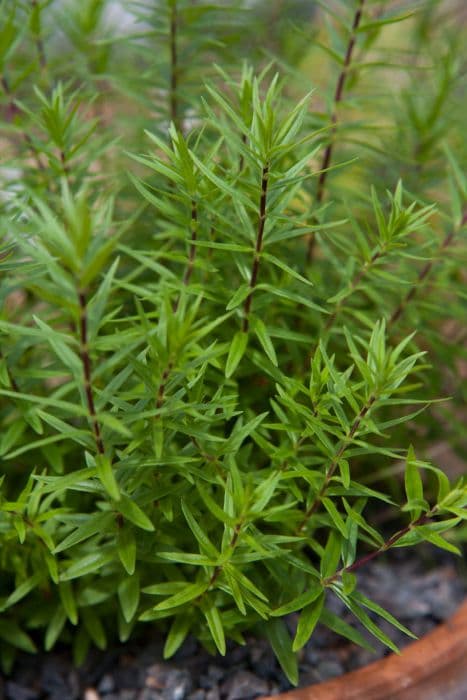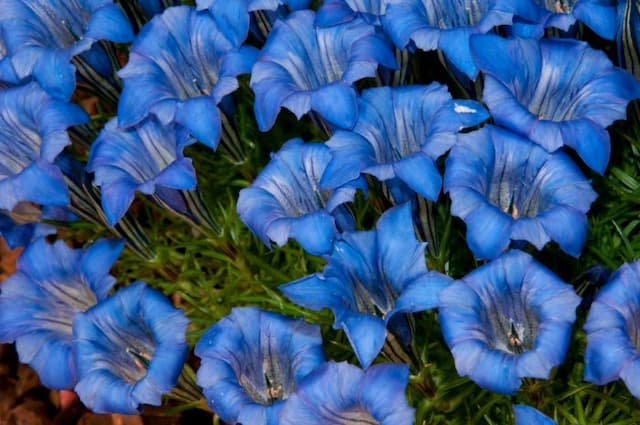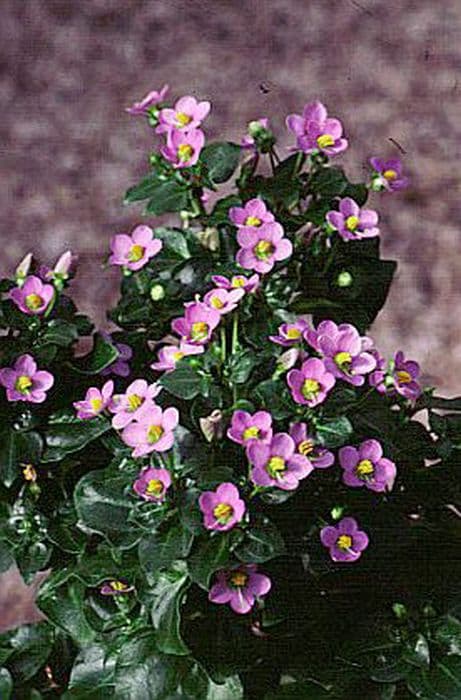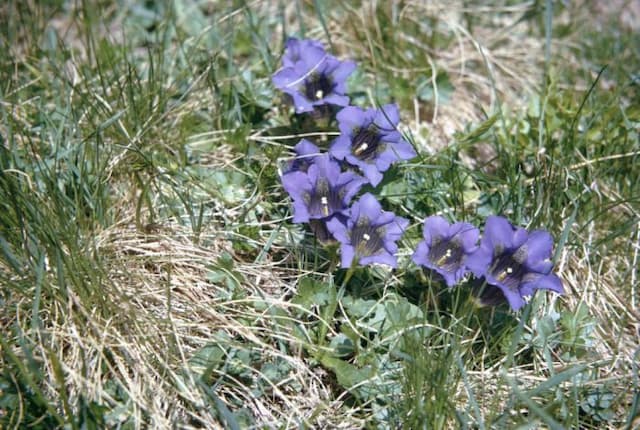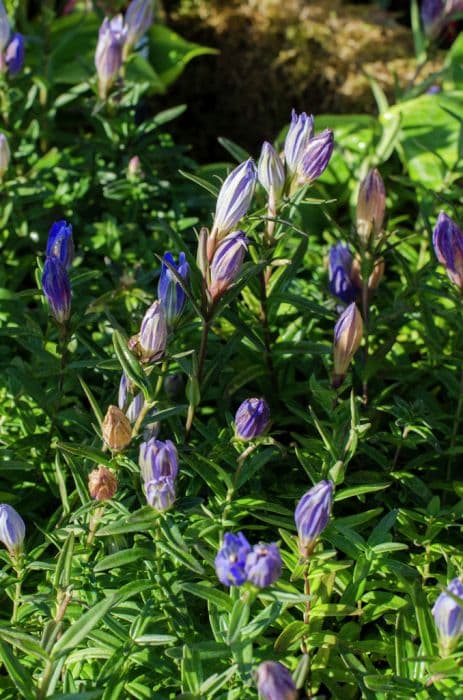Gentian Gentiana 'Blue Silk'

ABOUT
Gentiana 'Blue Silk', commonly known as Gentian, is a perennial plant known for its striking and vividly colored flowers. The blooms of the Gentian 'Blue Silk' are a rich, deep blue hue that can sometimes appear almost silken or velvety in texture. These trumpet-shaped flowers have a bold appearance that stand out against the plant's foliage. The leaves of this Gentian variety are lance-shaped, providing a verdant and lush backdrop for the flowers. The overall form of the plant is typically compact and bushy, contributing to its appeal in garden settings as an ornamental specimen. The Gentian 'Blue Silk' is admired for the intense coloration of its flowers, which are considered a highlight of the plant and often serve as a focal point in plant compositions.
About this plant
 Names
NamesFamily
Gentianaceae
Synonyms
Blue Silk Gentian, Silk Gentian
Common names
Gentiana 'Blue Silk'
 Toxicity
ToxicityTo humans
The Gentian 'Blue Silk' is not commonly known to be toxic to humans. However, as with any plant, individual allergic reactions or sensitivities are possible. If large quantities are ingested, it could potentially cause gastrointestinal discomfort, but there are no widely known toxic effects from ingesting this plant. Always exercise caution and consult medical professionals if ingestion occurs and adverse symptoms are experienced.
To pets
The Gentian 'Blue Silk' is not commonly known to be toxic to pets such as dogs and cats. Pets may sometimes experience mild digestive upset if they ingest parts of this plant, but it is not considered significantly toxic. As with any non-food plant, keep an eye on your pet if they consume any part of the Gentian 'Blue Silk' and contact your veterinarian if you observe unusual symptoms or behaviors.
 Characteristics
CharacteristicsLife cycle
Perennials
Foliage type
Deciduous
Color of leaves
Green
Flower color
Blue
Height
1-2 feet (30-60 cm)
Spread
1 feet (30 cm)
Plant type
Herb
Hardiness zones
5
Native area
Europe
Benefits
 General Benefits
General Benefits- Ornamental Value: Adds vibrant blue color to gardens with its striking, silk-like flowers.
- Low Maintenance: Requires minimal care once established, making it suitable for busy gardeners.
- Drought Tolerance: Can survive in dry conditions, reducing the need for frequent watering.
- Cold Hardy: Can withstand cold temperatures, suitable for planting in a variety of climates.
- Attracts Pollinators: Flowers attract bees and butterflies, promoting biodiversity.
- Long Blooming: Provides a long period of floral display from late spring to early fall.
- Compact Growth: Suitable for small gardens or containers due to its non-invasive nature.
- Deer Resistance: Typically not a preferred choice for deer, reducing the risk of damage.
- Alpine Origin: Well-suited for rock gardens and alpine settings, reflecting its natural habitat.
- Soil Adaptability: Adaptable to various soil types, though prefers well-drained soils.
- Versatility: Can be used in borders, mass plantings, or as a focal point in a garden design.
 Medical Properties
Medical PropertiesThis plant is not used for medical purposes.
 Air-purifying Qualities
Air-purifying QualitiesThis plant is not specifically known for air purifying qualities.
 Other Uses
Other Uses- Garden photography: Due to its vibrant blue flowers, Gentiana 'Blue Silk' is often used as a subject in garden and plant photography, providing a vivid pop of color.
- Educational tool: Horticulture and botany educators may use this plant to teach students about alpine flora and plant survival in different environments.
- Insect attraction: The plant can serve as an attractant in gardens for beneficial pollinators like bees and butterflies, supporting local ecosystems.
- Bioindicator: Gentiana 'Blue Silk' could be used as a bioindicator to monitor the health of an ecosystem, as some species flourish in certain conditions while others may indicate soil or air quality issues.
- Artistic inspiration: Artists may use Gentiana 'Blue Silk' as inspiration for paintings, illustrations, or textile designs due to its striking color and form.
- Theme gardens: It can be used in thematic garden designs such as blue gardens or alpine rock gardens, where it contributes to the overall aesthetic.
- Fragrance gardens: While not known specifically for its scent, it can be included in fragrance gardens to provide visual diversity.
- Color theory studies: The intense blue of Gentiana 'Blue Silk' provides a practical example for students and designers studying color theory and the visual impact of complementary colors in landscape design.
- Culinary decoration: The flowers can be used as a garnish for culinary dishes, although they are not commonly eaten; always ensure they are free of pesticides and safe for consumption if used in this way.
- Floral arrangements: Fresh or dried, the flowers of Gentiana 'Blue Silk' can be used in floral arrangements for their distinctive color and shape.
Interesting Facts
 Feng Shui
Feng ShuiThe plant Gentian is not used in Feng Shui practice.
 Zodiac Sign Compitability
Zodiac Sign CompitabilityThe plant Gentian is not used in astrology practice.
 Plant Symbolism
Plant Symbolism- Perseverance and Endurance: The Gentian plant, with its capacity to grow in harsh mountainous environments, symbolizes the ability to endure difficult conditions and continue to thrive, reflecting strength of character.
- Victory after Struggle: Because Gentians bloom even in the face of challenging climates, they represent overcoming obstacles and eventual success following perseverance.
- Resilience: The plant’s robust nature and survivability in cold climates make it a symbol of resilience and the capacity to recover from setbacks.
- Attraction: With its striking blue flowers, Gentians symbolize an attractive quality and the power to draw in admiration and interest.
- Deep Emotions: The intense blue of the Gentian's petals is often associated with depth of feeling and sincerity.
 Water
WaterGentians prefer consistent moisture, so water your 'Blue Silk' gentian when the top inch of soil feels dry to the touch. On average, this might mean watering once a week, but this can vary depending on climate and weather conditions. It's important not to let the soil dry out completely, but also to avoid overwatering, which can lead to root rot. For a potted 'Blue Silk' gentian, you might use approximately a pint to a quart of water each time, depending on the size of the pot and the environmental conditions. Always allow excess water to drain away to prevent waterlogged soil.
 Light
Light'Blue Silk' gentians thrive in full sun to part shade. They should be placed where they will receive at least four hours of sunlight daily but will also benefit from some protection during the hottest part of the day, especially in warmer climates. An ideal spot would be one that offers morning sunlight and dappled afternoon shade.
 Temperature
Temperature'Blue Silk' gentians are hardy in a range of temperatures but grow best in cooler conditions. They can typically withstand temperatures as low as 20°F and as high as 80°F. However, they prefer a range of 50°F to 70°F for optimal growth.
 Pruning
PruningPruning 'Blue Silk' gentians helps maintain their shape and remove dead or faded flowers, which can promote further blooming. Deadheading should be performed throughout the blooming season to encourage more blooms. Pruning for shape is best done in early spring before new growth begins. Pruning can also be used to remove any damaged or diseased foliage whenever necessary.
 Cleaning
CleaningNot needed
 Soil
SoilGentians require well-drained soil with a pH of 5.5 to 7.0. A mixture of loamy soil, peat, and perlite or sand facilitates the drainage that 'Blue Silk' gentians need to thrive.
 Repotting
Repotting'Blue Silk' Gentian should be repotted every 2-3 years to refresh the soil and accommodate root growth. It's best done in spring or early summer.
 Humidity & Misting
Humidity & Misting'Blue Silk' Gentian thrives in moderate humidity levels, typical of outdoor environments; avoid overly dry or highly humid conditions.
 Suitable locations
Suitable locationsIndoor
Ensure bright light, cool temps, and moist soil for 'Blue Silk' Gentian.
Outdoor
Plant in part-shade, moist soil, and protect from harsh sun.
Hardiness zone
3-8 USDA
 Life cycle
Life cycleGentiana 'Blue Silk', commonly known as Blue Silk gentian, begins its life cycle when seeds germinate in late winter or early spring, given cold stratification to break dormancy. Seedlings emerge and develop into rosettes of foliage, preferring well-drained, consistently moist soil and partial to full sun conditions. Throughout spring and into summer, the plants mature, producing stems that may reach up to 12-24 inches tall. In mid to late summer, Blue Silk gentian produces its signature trumpet-shaped, brilliant blue flowers, which attract pollinators like bees and butterflies. After pollination, seeds develop and are dispersed in late summer or fall, allowing the cycle to begin anew. In cold climates, the plant dies back to the ground in winter, but the perennial root system remains alive to sprout again the following spring.
 Propogation
PropogationPropogation time
Spring-Early Summer
Propogation: The most popular method of propagating Gentiana 'Blue Silk', also commonly known as Gentian, is by seed. To successfully propagate Gentian by seed, sow the seeds in a well-draining soil mix after the last frost date in spring. Seeds need cold stratification; hence, they should be mixed with moist sand and stored in the refrigerator for several weeks before planting. Once stratified, scatter the seeds on the soil surface and lightly press them in without covering them, as they need light to germinate. Keep the soil consistently moist, but not waterlogged. Seedlings will emerge in a few weeks, after which they can be thinned and eventually transplanted to their final location.
